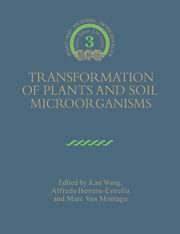Book contents
- Frontmatter
- Contents
- List of Contributors
- Series Preface
- Preface
- Acknowledgements
- Abbreviations and Terms
- Part I Transformation of Soil Microorganisms
- Part II Transformation of Cereal Crops
- Part III Transformation of Industrially Important Crops
- 8 Leguminous Plants
- 9 Spring and Winter Rapeseed Varieties
- 10 Sunflower
- 11 Forest Trees
- Index
11 - Forest Trees
Published online by Cambridge University Press: 04 August 2010
- Frontmatter
- Contents
- List of Contributors
- Series Preface
- Preface
- Acknowledgements
- Abbreviations and Terms
- Part I Transformation of Soil Microorganisms
- Part II Transformation of Cereal Crops
- Part III Transformation of Industrially Important Crops
- 8 Leguminous Plants
- 9 Spring and Winter Rapeseed Varieties
- 10 Sunflower
- 11 Forest Trees
- Index
Summary
Introduction
Forest trees dominate the temperate and tropical ecosystems and the wood produced by trees is the most abundant biological material on the earth's surface (Gammie, 1981). Wood provides fuel for much of the population of the world, and wood is a leading industrial raw material. In the United States, wood accounts for 25% of the value of all industrial materials and exceeds them in amount (National Research Council, USA, 1990). Increased environmental concern requires that more forest is preserved and that less cutting be carried out in natural forests. To meet the increased demand for wood, more wood needs to be produced on less land through genetic improvement and intensive management (Buonjiorno & Grosenick, 1977; USDA Forest Service, 1982).
Genetic improvement of forest trees is a slow process. The most advanced tree-breeding programs have carried out only a few generations of selection. Forest trees are largely undomesticated plants and differ from many agronomic crops that have been cultivated and selected for thousands of years. Furthermore, trees are not annual crops, and one generation for many species can take 20 years or more.
Genetic engineering has great promise for agriculture because it can accelerate traditional breeding, bypass long generation times and cross reproductive barriers through gene transfer technology. If this is true for agricultural crops, then genetic engineering should be a greater advantage to forestry because traditional methods have been slower and more difficult. The application of genetic engineering technology to tree improvement has been slow also because the necessary techniques and information are not available.
- Type
- Chapter
- Information
- Transformation of Plants and Soil Microorganisms , pp. 150 - 163Publisher: Cambridge University PressPrint publication year: 1995
- 4
- Cited by

